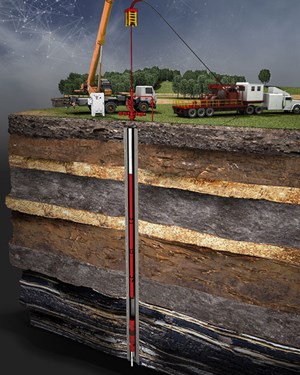Profitability requires change, now
In terms of production efficiency, the upstream oil and gas industry was overdue for a major change. Well, it has arrived. And with it, world events have accelerated us farther down that path, much faster than anyone ever thought possible.

Our goal—to safely produce hydrocarbons for less—has never wavered and has generated tremendous technical innovation, as our average work environment has crushing pressures and is often more than 2 mi deep and located in remote, desolate parts of the world. That said, we can hit an underground target within a few feet. We take pride in our completely homegrown innovation.
But our goal became significantly more complex last year. As Covid-19 forced us to quickly rethink how we can and should run our businesses, it also became crystal-clear that we must reduce workforce presence at operational sites and in our business offices. Other industrial sectors had already leveraged remote decision-making, monitoring, analysis, collaboration, and equipment control. We found out how far we were behind and had to close the gap very quickly.
Then came the crash in oil prices, which deeply affected CAPEX and OPEX spending for every company in our industry. This generational event for the oil field caused every person and every company to find ways to drastically cut costs. Imagine if Apple realized that the phone they typically sell for $500 must now be delivered for just $200, with no changes to the product. Plus, they only have the amount of time to make it happen that cash-on-hand allows.
Additionally, as the world demands—including our customers and peers, and even we demand it of ourselves—that we reduce our global impact and work toward a reduced-carbon future. We must reduce waste, carbon emissions, and the overall environmental effect of our business. It’s time we realize that working in the oil field and acting as ESG-conscious citizens is far from mutually exclusive.
The good news of this past year, if anything, has shown us that change is not only possible, but can be done well and done quickly. Covid-19 has proven how readily we can adapt to remote decision-making and collaboration while sequestered at home. It is time to maintain and add to these gains.
PROFIT FROM YOUR EXISTING ASSETS
A smart man once told me that the most profitable asset you will ever produce is the one you have. Ironically, most of our historic R&D spending in the industry has been directed toward new assets.
Our industry mantra can be reduced to a simple quest for excellence: To safely produce more barrels for fewer dollars. For decades, this pursuit has driven technological advances, including fracturing in completions and significant efficiency gains in drilling. However, each of these disciplines has essentially plateaued, and further advancement is expected to be incremental, at best. Production, however, holds the last remaining frontier for true efficiency gains.
Dollars invested in the production phase are far more likely to deliver substantial returns on investment. According to industry research, dollars spent toward increasing uptime for your wells and facilities generate a 10% to 20% return. Dollars spent toward proactive management of a lift system can generate another 5% to 10% return. When uptime is increased, you reduce the number of engineers needed per well. This is how one of our super-major clients is able to operate tens-of-thousands of wells with only 14 engineers. When you proactively manage your producing wells and lift systems, you do so with data—and data is power, Fig. 1.

UNDERSTAND THE WELL, ELIMINATE COPY-AND-PASTE SET POINTS
Today, nearly all wells operate—or will operate—on artificial lift, which essentially pulls hydrocarbons out of the reservoir when natural pressure cannot do it alone. As the vice president for Artificial Lift at one of the largest oilfield service companies, I can say that the efficiency gains we need will not come exclusively from newer, better, and more reliable equipment. While my company, indeed, makes differentiated equipment that reduces the cost of asset ownership—our Rotaflex long-stroke pumping unit and Racer severe-service couplings are good examples—the opportunities for a paradigm shift in productivity gains lay in gathering the data we generate and then using them to our advantage.
Most artificial lift wells are managed, using traditional controllers that behave like conventional thermostats at home, which control your heating and air conditioning equipment, based on a set point you program. In the oil field, automation devices like rod pump controllers, maintain a certain set point. Any changes beyond this require a visit to the field. However, these devices and their wells are often set up as an inferred estimate from nearby wells in copy-and-paste fashion, using the same set points, pump speeds, and chemical treatment programs, and largely regardless of the individual well’s production history. The future is about treating wells like individual patients, with unique needs and problems.
As nearby wells can have very different fluid and mechanical properties, logic tells us that each well should have a unique artificial lift diagnosis and prescription. We could avoid a lot of trial, error and pain by understanding how each well behaves, then acting prescriptively, based on that knowledge, Fig. 2.

The production world is headed toward leveraging these data directly from the well in real time. High-frequency data give us a detailed diagnosis of well health, as well as the tools needed to prescribe customized and efficient lift solutions. Altogether, these breakthroughs represent the beginning of managing wells by exception rather than reaction; autonomous lift is the quintessential game-changer for artificial lift.
MAKING THE OLD NEW AGAIN
The upstream industry, from producers to service companies to third-tier suppliers, spent the past year cutting OPEX and CAPEX. Apart from finding and cutting operational efficiency problems—most have been weeded out over the past several years of lower oil prices—the only viable solution left is digitalization. This means it is time for the oil field to embrace IoT, Cloud computing, and artificial intelligence in a big way. And it needs to happen fast.
The silver lining here is that this technology already exists and is readily available. We, as an industry, simply need to harness it. Many companies, including mine, are embracing digitalization to help produce more barrels at a lower cost, which also has the added benefit of reducing operational carbon footprint.
Industry 4.0 applications are currently live in the oil field, including a forward-thinking producer in Texas. By embracing Industry 4.0 concepts, the company expects an annualized savings of $17.7 million per year from here on out. These are the changes we need on a much wider scale.
Modern data-management and computing tools integrate the old and the new—equipment, software, IoT, analytics, Cloud and Edge computing—to deliver game-changing productivity for nearly any well. Cloud technology enables remote monitoring, analysis, and decision-making for the office or home. At the wellsite, that same computing power is the prime enabler for autonomous decisions. These are made every second of every day, continuously, to maximize production performance and reduce downtime.
True closed-loop autonomous controls transform previously dumb iron into self-prescribing, self-healing intelligent machinery. Taking the above analogy one step further, we can upgrade the conventional thermostats in our homes to autonomous control and self-learning operations. In the field, autonomous control helps artificial-lift machinery learn how to best run itself, get the most of the well efficiently, and call for help when needed. Think of it as having a dedicated engineer sitting on the well, looking at the data, and making profitable decisions that optimize performance every single second. This is a huge step in reducing boots on the ground and greatly enhancing safety.
At Weatherford, this capability is contained in a small, next-generation device that is connected to any well controller or existing communications network. ForeSite® Edge has proven that autonomous well control is simple and inexpensive to install.
AUTONOMOUS LIFT CONTROL TODAY
People often ask how autonomous control works. So, let’s step aside for a dramatic recreation. Picture a lone, reciprocating rod-lift pumping unit operating in the Permian basin. Attached to the VSD is a small, weatherproof box connected to the Cloud. It accesses reams of data, and the well engineering models onsite, to constantly decide how best to optimize each stroke and the next. Suddenly, the small box detects a developing trend, deep within a pump submerged nearly 2 mi below the surface.
As the well’s reservoir dynamics change, ForeSite Edge determines the current pumping rate will leave valuable hydrocarbons downhole, or in other words, leave an under-pumped well. The possibility of increased flow will be excellent news for the operator, but he does not yet know. However, the autonomous control logic makes the decision increase idle time to maximize production. In just seconds, this previously dumb-iron artificial lift system acted on its own to earn its operator more total production, without human intervention.
Gone are the days when this situation would have simply been unnoticed, or at best, would have taken weeks to discover and adjust by scheduled maintenance and manual observations. The intelligent, autonomous lift system did it alone and with no human interaction.
Moreover, at those wells—be it rod lift, gas lift, electric submersible pump (ESP), or progressing cavity pumping—autonomous controllers also provide a complete history of the well, which is particularly relevant today. As previously shut-in wells are set to be brought back online, the OPEX costs will make it obvious that next-generation well intelligence and automation is the right investment. We have to know how the well behaved before shut-in, to figure out how to restart equipment and begin production safely and efficiently. However, the reality is that many wells lack the historical data to determine a restart plan.
Take, for example, an idled ESP with scale or paraffin build-up. Starting that ESP can lead to serious equipment damage, which drives up costs and narrows profit margins. While the risk is lower in other forms of lift like rod lift, the challenges are similar. No matter how a well is operated, the principle that helps us understand and optimize well operations is high-frequency data at the wellsite.
Furthermore, when optimally operating a lift system 100% of the time, autonomous control delivers additional benefits. These include significant gains in equipment reliability, reduced ESG risks (including overall impact), and the power to determine the optimal lift solution for the life of a well.
PROVEN RESULTS WITH AUTONOMOUS LIFT CONTROL
A common misconception is that autonomous control is suited only for high-value or prolific wells. The reality is that this technology is equally applicable to most wells. Repeated field results indicate that Edge technology can pay for itself in only a few days of saved downtime on wells that produce 20 to 30 bpd. When that math is applied to a group of wells, a pad, or a field, the return on investment quickly climbs into the multi-millions.
One example is a rod-lift operator, which implemented ForeSite Edge on three wells to increase production by 6%, reduce wellsite visits by 70%, and reduce failures by 15%. The technology enabled remote monitoring for key performance measurements, such as strokes per minute (SPM), pump fillage, effective runtime, strokes per day, and more. These data led to optimization opportunities in each well. In two VSD-operated wells, autonomous control leveraged high-frequency data to optimize the VFD Min/Max frequency while maintaining the target pump fillage. In an RPOC-operated well, autonomous control logic was applied toward idle-time optimization to manage pump fillage. Together, these simple, inexpensive changes generated a revenue return of more than $200,000 per year, every year, with just three wells.
Another example is a gas-well operator, which used Edge technology to increase production by 25% and reduce costs, in the form of buyback gas, by 25%. Prior to adopting this technology, the asset relied on pumpers and field technicians to travel to the wellsite and perform manual pressure adjustments. This hands-on process typically required eight separate trips over a week at a cost of more than $1,000 per well. The operator was able to remotely adjust the flowing bottomhole pressure range, which was maintained autonomously by the device. Altogether, this enabled significant improvements in personnel efficiency and Covid-19 operational-safety compliance.
AUTONOMOUS CONTROL IN THE FUTURE
Embracing the current market outlook—that lower oil prices may be here to stay—helps us to understand that reactionary asset management is neither profitable nor acceptable. The lost time and productivity required to isolate the cause of a well’s production problem, respond to it, and then get production moving again now represents the difference between attaining any margin at all and remaining in business. Regardless, whether an investor manages 30 wells or 30,000, the chief challenge is doing more with less, as there are fewer available resources in terms of capital and personnel.
Due to the success of autonomous control in lift operations, we at Weatherford are looking to expand this idea beyond current bounds. Our autonomous workflows may be combined with our rig-less intervention techniques to help operators not only decide to optimize equipment changes like a downhole pump, but also seamlessly program the operation from start to finish. The future of artificial lift is here, and it is autonomous control at the wellsite.
- Advancing offshore decarbonization through electrification of FPSOs (March 2024)
- Digital transformation/Late-life optimization: Harnessing data-driven strategies for late-life optimization (March 2024)
- The reserves replacement dilemma: Can intelligent digital technologies fill the supply gap? (March 2024)
- What's new in production (February 2024)
- Subsea technology- Corrosion monitoring: From failure to success (February 2024)
- Digital tool kit enhances real-time decision-making to improve drilling efficiency and performance (February 2024)
- Applying ultra-deep LWD resistivity technology successfully in a SAGD operation (May 2019)
- Adoption of wireless intelligent completions advances (May 2019)
- Majors double down as takeaway crunch eases (April 2019)
- What’s new in well logging and formation evaluation (April 2019)
- Qualification of a 20,000-psi subsea BOP: A collaborative approach (February 2019)
- ConocoPhillips’ Greg Leveille sees rapid trajectory of technical advancement continuing (February 2019)


